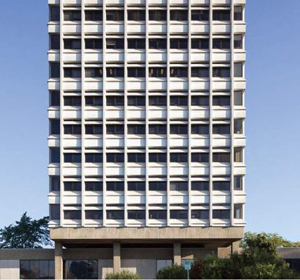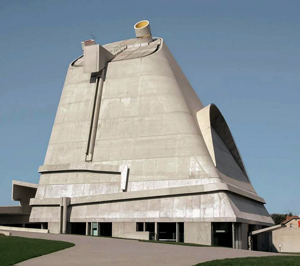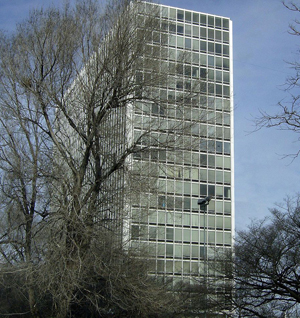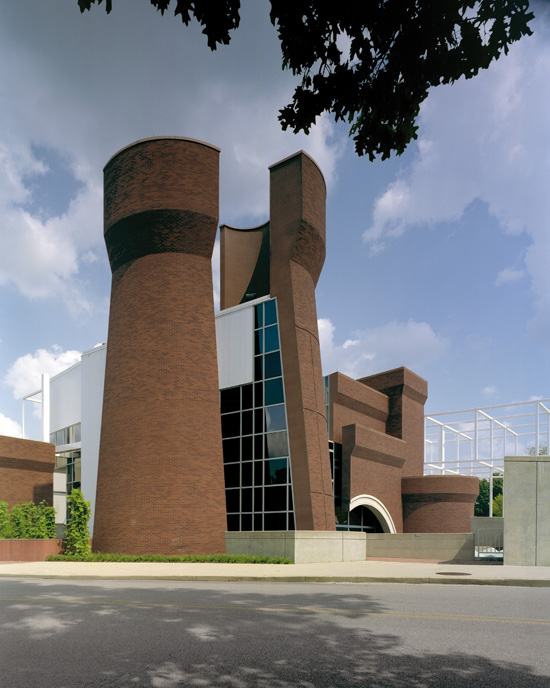Artificial Architecture
by Theodore Dalrymple (July 2023)

Telemath, John McHale, 1958
One day, perhaps not in the very distant future, artificial intelligence will be able to compose a thousand Mozart symphonies, string quartets, piano concerti, operas, and sonatas, that are just as good as his. A machine will paint Vermeers and Chardins and write sonnets as good as Shakespeare’s.
Will we be glad of it, and if not, why not? After all, the sum total of beauty in the world will have been increased, and beauty and its increase is one of the three great desiderata of human life.
But the prospect does not please us, I suspect, or at least most of us. The reason is that our place in the world will have been usurped by our own inventions. If machines can compose Mozart, what is there for the rest of us to do?
 But it is not only future machines that will have usurped the human: architects have done it already. They need no artificial intelligence to have done so, just a lack of ordinary human intelligence and decency combined with the overweening ambition of small minds. There is no bad theory that they have read, marked, learned and inwardly ill-digested, to adapt slightly the Church of England’s Book of Common Prayer. This is made perfectly clear by Branko Mitrović, in a short but incisive book, Architectural Principles in the Age of Fraud: Why So Many Architects Pretend to be Philosophers and Don’t Care how Buildings Look (ORO Press).
But it is not only future machines that will have usurped the human: architects have done it already. They need no artificial intelligence to have done so, just a lack of ordinary human intelligence and decency combined with the overweening ambition of small minds. There is no bad theory that they have read, marked, learned and inwardly ill-digested, to adapt slightly the Church of England’s Book of Common Prayer. This is made perfectly clear by Branko Mitrović, in a short but incisive book, Architectural Principles in the Age of Fraud: Why So Many Architects Pretend to be Philosophers and Don’t Care how Buildings Look (ORO Press).
The brief answer is that architects no longer have the skills to build other than inhumanly. The two great wars of the last century had a decisive effect on architecture, first in the west and then in the whole world. The Great War thinned out the ranks of young, traditionally-trained architects and gave an opportunity to the untrained, such as the holy trinity of modernism, Walter Gropius, Ludwig Mies van der Rohe and Le Corbusier who, had it not been for that war, would have sunk into well-merited obscurity. Their skills were more those of self-promotion, propaganda, and bureaucratic infighting than of actual building, of which they did relatively little, but it was the Second World War that gave their style, worldview, philosophy and methods an all-conquering impetus. The world was in search of a means of building, and rebuilding, on a huge scale, cheaply and quickly. The main difference between the communist and non-communist worlds was in the quality of the materials used and in the competence of the construction, not in any aesthetic quality. Communist architecture had one great theoretical advantage over the capitalist variety: that it was easier to demolish than its capitalist counterpart. Indeed, it was often auto-demolishing.
All architecture since then, in apostolic (though also demoniac) succession to the founders, has failed to recover any sense of the human. One of the tenets of modernism was the abjuration of ornament, though until its advent ornamentation in architecture had been universal, albeit very changeable—and gloriously so, only the modernists had the idea of imposing themselves and their style upon the whole world.

But the puritanical abjuration of ornament could not last long, it was too opposed to what humans spontaneously desired. Two things happened. The first was that modernist buildings began to be adorned, if that is quite the word, with ornaments fixed upon them as though by afterthought. These ornaments, designed by modern artists, were almost without exception abominable, and for a very good reason: a process similar to that of the destruction of architectural education (architecture was much better when it was taught in a system of apprenticeship than as a subject in the corrupt groves of academe) had taken place in the art schools, where generation after generation of technical incompetents had come to rule the roost. Artists were no longer capable, by and large, of art, only of para-artistic activity; while those relatively few who escaped the baleful influence of art schools were sidelined from most projects. In this perverse and perverted world, a good example would have been a bad example: it would certainly be a reproach.
The second thing that happened was the adoption of weirder and weirder forms, the forms themselves taking the place of ornamentation. The justification for these forms paralleled the para-artistic activity of art schools: the architects learned to speak in para-philosophical language, which actually was mere verbiage if not outright verbigeration. By this means, they were able to insinuate to others that they were prey to deep thoughts, and thereby intimidate clients into believing that if they did not accept their ever more grotesque designs, it was for lack of understanding. Those without understanding could not appreciate their work; those with it, could.
Mr Mitrović provides many examples of architects’ philosophising, and that of their hangers-on, the architectural critics and academics. I will quote one short example: any more would give the reader the impression that his mind had been put through the mental equivalent of a food-mixer, moreover one that had been filled with totally incompatible ingredients, say kippers, honey and cabbage. Architect and theorist Christian Norberg-Schulz says:
Word opens the world, while work gives it presence. In the work the world is placed back to the earth, that is, it becomes part of the immediate here and now, whereby the last-mentioned appears in its existence. (p. 46)
It is not worth puzzling long over this.

Architects who write favour the imperative mood. Le Corbusier was the progenitor of this tendency: he gave orders without explaining them. ‘The plan must rule,’ he once wrote, without explaining why the plan must rule. Architects once also received orders, though not from human beings, which they then transmitted like radio masts. They, the architects, did not make choices: they followed the dictates of the age or place in which they lived. Norberg-Shultz continues:
Architecture is not a result of the actions of man, but rather it renders the world that makes these actions possible. (p 59)
It is the zeitgeist, the spirit of the age, that architects enjoined themselves to follow, as if the zeitgeist were independent of the activities of all the humans that made it what it was. As criminals blame their circumstances for their crimes, so architects blamed the zeitgeist for the ugliness with which they have since covered the world.
However, architects grew tired of the dictates of the zeitgeist à la Corbusier and have since sought absolute liberty to do whatever they choose, as free artists completely untrammelled by what has gone before or by the surroundings of what they build. Harmony even became a dirty word for them. Originality was their holy grail, the unthought of and the unthinkable being their highest aim. At least they chose an ambition easy of achievement: nothing is easier than originality divorced from any other quality.

When it comes to prescriptive idiocy, I think the so-called deconstructivists take the biscuit. Peter Eisenman, a theorist and practitioner of architectural deconstructivism, some of whose pronouncements are at least comprehensible, thus revealing their true evil, once said that the best architecture was incongruous and disharmonious. This is surely a thought so self-evidently stupid (as well as evil) that it must have taken many years of education for Eisenman to have it, and then apparently to mean it. How could anyone even so much as glance at Venice and conclude that the best architecture is disharmonious—unless, that is, the word is used in some solipsistic technical sense?
Eisenman once said that he wanted buildings that made people think rather than feel, as if human existence could be separated from either and one had to choose between the two. Mr Mitrović quotes Eisenman describing the houses he designed. They were intended, he said:
… to dislocate the house from that comforting metaphysic and symbolism of shelter in order to initiate a search for those possibilities of dwelling that may have been repressed by this metaphysic … While a house today still must shelter, it does not need to symbolize or romanticize its sheltering function; to the contrary, such symbols are today meaningless and merely nostalgic.
There are so many false assumptions and ill-expressed assertions in this passage that perhaps the best way to criticise it is to satirise it:
… to dislocate surgery from that comforting metaphysic and symbolism of cure in order to initiate a search for those possibilities of treatment that may have been repressed by this metaphysic. While surgery today must still cure, it does not need to symbolize or romanticize its curative function; to the contrary, such symbols are today meaningless and nostalgic.
As Mr Mitrović points out, prominent contemporary architects don’t really intend what they say or write to be taken so seriously that they should be examined using such blunt and vulgar instruments as logic or historical knowledge. To take but one obvious error in the above passage (it would take an entire essay to expose all its errors and evasions), a symbol cannot be both meaningless and nostalgic. One may not think nostalgia a useful emotion in practice—though I think a life of any length without nostalgia must have been very ill-lived or shallow—but it is definitely not meaningless.

The vogue for Eisenman theories passed, though not because they were bad. The purpose of writing by architects is not to seek truth or even good sense, but to establish that the writer is a member of the guild of the avant garde. But what, exactly, is the advance guard the advance guard of? What is it marching towards? The only possible answer is to the unprecedented; but as soon as the unprecedented is built, it becomes precedented, and therefore old hat, hence the ceaseless search for what has never been done before, irrespective of whether it is any good from any other point of view than novelty. So long as architects can have bad ideas, which are so much easier to have than good ones, there will be novelty in this sense; but no quality is more fleeting than such novelty, which leaves behind it a trail of devastation.
I write this in the city of Bordeaux. It required no Eisenman to promote disharmony here: every architect of every building in the centre of the city constructed after the last world war did it, though the disharmony increased with the decades. As one looks out from the gardens of the Hôtel de Ville, the magnificent late eighteenth-century palace built for the archbishop, one sees a standard modernist office tower placed as if to disrupt, discomfit, disturb, destroy, all of it without the aid of Eisenman’s deconstructivism.
This, perhaps, is the consequence of people looking at buildings exclusively through the lens of their political ideas, wilfully suppressing their aesthetic judgment. The Hôtel de Ville, after all, is the architecture of inequality and injustice; that of the modernist office tower, if not that of equality and justice, exactly, at least that of progress thereto.
A mob not long ago burned the splendid doors of the town hall, which will now be replaced at huge cost to the city, and therefore to the city’s taxpayers. If the mob had gained access to the Hôtel de Ville, goodness knows what further damage it would have done. It was in arson so deeply stepped that, should it burn no more, returning were as tedious as to go o’er.
The building was, of course, a symbol of the government, or perhaps of government as such: but France is not exactly short of government buildings to burn down, many of them hideous. I do not think it entirely a coincidence that so elegant a building should have been chosen as a target by the spoilt educated vandals. To the contrary: while beauty is one of the great values of human existence, it is also, especially if man-made, a constant reproach to the pettiness and ugliness of our lives. Since most of us cannot so arrange our lives as to live surrounded by beauty, let alone to create it (an incapacity which we experience as a wound to our self-importance), some of us, at least, come not to esteem beauty but to hate it, and wish to destroy it wherever we find it. Among such people are our prominent architects and teachers of architecture.
Table of Contents
Theodore Dalrymple’s latest books are Neither Trumpets nor Violins (with Kenneth Francis and Samuel Hux) and Ramses: A Memoir from New English Review Press.
Follow NER on Twitter @NERIconoclast